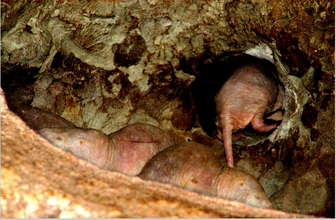
World's Weirdest - Naked Mole Rats

A naked mole rat's view of colonial life. (Getty Images)
The naked mole rat, Heterocephalus glaber, belongs to the Bathyergidae family, a group of rodents that are native to sub-Sahara Africa, living mainly in the arid regions of Ethiopia, Kenya and Somalia.
One of the most unique aspects of the naked mole rat is the fact that they are one of two mammals, the other being the damaraland mole-rats, to exhibit eusociality, the colony like behavior that is typically exhibited in insect species such as ants and bees. Naked mole-rats live in colonies that typically range from 70 to almost 300 individuals. A caste system is in place within the colony. In each colony, there is a queen, the sole breeding female, and between one and three males with which she mates. The other colony members are non-breeding males and females that are “workers” and responsible for digging tunnels, finding food, and helping care for the young. Scientists believe that the naked mole-rat’s eusocial system evolved as a result of their underground lifestyle and the harsh environment in which they live. Excavating tunnels can be exhausting work. Spreading the labor among multiple individuals accomplishes the task much quicker and with less effort on each individual (Cohn 1992). Food sources may also be scarce or widely spread, which would make it difficult for an individual or even a pair to survive on their own. In a colony, many workers search for food that will then be shared among the entire group (Brehm & Griffin 2007).
Literature Cited[]
Brehm L. & Griffin J. (2007). Mammalian Eusociality. Retrieved from: http://academic.reed.edu/biology/professors/srenn/pages/teaching/web_2007/molerats_LB_JG/index.html
Cohn, Jefferey P. (1992). Naked Mole-Rats. BioScience 42 (2), 86-89
Eusociality vs. Cooperative Breeding[]
Cooperative Breeding is something humans participate in, for example many times multiple generations will live together, all depends on your family situation. Also alloparenting happens many times as well, when looking at if grandmothers, aunts, uncles or brothers may step in for the young of another family member, for either temporary or permanent time restraints.
Eusocial indicates that one would more than likely never mate while in their home / natal group. And they may leave one colony, and move to another colony, and still never breed. Naked Mole Rats are a perfect example of Eusociality in mammals, since more Eusocial organisms are arthropods/insects. There is a queen that does all of the breeding, until she passes away. There are very rare times that extra breeding occurs in the colony since all the members are busy doing different things.
One animal society that can be considered cooperative breeders instead of eusocial, to illustrate the difference would be meerkats. Russell et al. defines the meerkat as a cooperative breeding species where the social group includes a dominant male and female breeder and a number of nonbreeding female and male helpers that will assist in rearing the young.
Eusociality and cooperative breeding are two different types of social groups—eusociality is a caste system that forms due to irreversible physical casting (as in ants/bees and the sterile workers) unlike that of the meerkat. The physical casting stops the others from being able to physically breed. In meerkat society, the other subordinate females and males are still physically able to breed, even thought breeding is not usually tolerated, where those who breed successfully are usually forced out.
Nat Geo, Meerkat Moms and Cooperative Breeding. http://news.nationalgeographic.com/news/2006/03/0315_060315_meerkats_2.html
Boomsma, J. (2005). Lifetime monogamy and the evolution of eusociality. Philosophical Transactions of the Royal Scoiety B: Biological Sciences, 364(1533): 3191-3207.
Russell et al. (2003). Breeding success in cooperative meerkats: effects of helper number and maternal state. Behavioral Ecology, 14(4): 486-492.